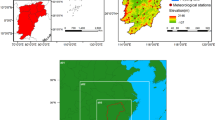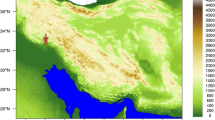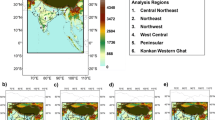Abstract
Realistic regional climate simulations are important in understanding the mechanisms of summer rainfall in the southeastern United States (SE US) and in making seasonal predictions. In this study, skills of SE US summer rainfall simulation at a 15-km resolution are evaluated using the weather research and forecasting (WRF) model driven by climate forecast system reanalysis data. Influences of parameterization schemes and model resolution on the rainfall are investigated. It is shown that the WRF simulations for SE US summer rainfall are most sensitive to cumulus schemes, moderately sensitive to planetary boundary layer schemes, and less sensitive to microphysics schemes. Among five WRF cumulus schemes analyzed in this study, the Zhang–McFarlane scheme outperforms the other four. Further analysis suggests that the superior performance of the Zhang–McFarlane scheme is attributable primarily to its capability of representing rainfall-triggering processes over the SE US, especially the positive relationship between convective available potential energy and rainfall. In addition, simulated rainfall using the Zhang–McFarlane scheme at the 15-km resolution is compared with that at a 3-km convection-permitting resolution without cumulus scheme to test whether the increased horizontal resolution can further improve the SE US rainfall simulation. Results indicate that the simulations at the 3-km resolution do not show obvious advantages over those at the 15-km resolution with the Zhang–McFarlane scheme. In conclusion, our study suggests that in order to obtain a satisfactory simulation of SE US summer rainfall, choosing a cumulus scheme that can realistically represent the convective rainfall triggering mechanism may be more effective than solely increasing model resolution.











Similar content being viewed by others
Notes
When computing the skill scores of rainfall simulations, we only consider the rainfall over the terrestrial SE US.
The 5-day spin-up time is determined based on our 15-day test simulation with various spin-up periods ranging from 0 day to 10 days. The rainfall bias over the SE US domain is calculated and it is found that rainfall bias sharply decreases when spin-up time increases to 3 days and is stabilized afterward. Thus, spin-up period longer than 3 days is needed to ensure the numerical stability of the simulation results. We choose a 5-day period to further ensure the adequacy of the spin-up time.
The wave number in the DCT algorithm can be converted to wavelength by the relationship, where \(k ={ \sqrt {m^{2} + n^{2} } }\) is the spatial wave number (m and n are the zonal and meridional wave numbers, respectively), and L is the length of the analysis domain (Denis et al. 2002).
The MYNN-3 scheme is not compatible with the Zhang–McFarlane scheme; thus the UW planetary boundary layer physics scheme is used in the simulation with the Zhang–McFarlane scheme.
The Lin microphysics scheme is used for the 10-yr simulation. For the simulation with Zhang–McFarlane (BMJ) cumulus scheme, UW (MYNN3) planetary boundary layer schemes are used.
The influence of data interpolation methods on the calculation of PCC and RMSE is noticed. Thus, multiple interpolation methods, including the nearest neighbor, kriging, bi-linear interpolation, and cubic spline, are compared. The specific PCC and RMSE values do vary among different methods. However, the conclusion does not change based on qualitative comparison of the 3-km simulation and the Zhang–McFarlane 15-km simulation.
References
AchutaRao KM, Sperber KR (2006) ENSO simulation in coupled ocean-atmosphere models: are the current models better? Clim Dyn 27:1–15
Adams DK, Souza EP (2009) CAPE and convective events in the Southwest during the North American monsoon. Mon Wea Rev 137:83–98
Alapaty K, Herwehe JA, Otte TL, Nolte CG, Bullock OR, Mallard MS, Kain JS, Dudhia J (2012) Introducing subgrid-scale cloud feedbacks to radiation for regional meteorological and climate modeling. Geophys Res Lett 39:L24809
Arakawa A (2004) The cumulus parameterization problem: past, present, and future. J Clim 17:2493–2525
Baigorria GA, Jones JW, O’Brien JJ (2007) Understanding rainfall spatial variability in southeast USA at different timescales. Int J Climatol 27:749–760
Bielli S, Roca R (2010) Scale decomposition of atmospheric water budget over West Africa during the monsoon 2006 from NCEP/GFS analyses. Clim Dyn 35:143–157
Betts AK (1986) A new convective adjustment scheme. Part I: Observational and theoretical basis. Quart J Roy Meteor Soc 112:677–691
Betts AK, Miller MJ (1986) A new convective adjustment scheme. Part II: Single column tests using GATE wave, BOMEX, ATEX and arctic air-mass data sets. Quart J Roy Meteor Soc 112:693–709
Bougeault P, LaCarrere P (1989) Parameterization of orography-induced turbulence in a mesobeta-scale model. Mon Wea Rev 117:1871–1890
Bowden JH, Nolte CG, Otte TL (2013) Simulating the impact of the large-scale circulation on the 2-m temperature and precipitation climatology. Clim Dyn 40:1903–1920
Bukovsky MS, Karoly DJ (2009) Precipitation simulations using WRF as a nested regional climate model. J Appl Meteor Climatol 48:2152–2159
Castro CL, Pielke RA Sr, Leoncini G (2005) Dynamical downscaling: assessment of value retained and added using the regional atmospheric modeling system (RAMS). J Geophys Res 110:D05108
Chen F, Dudhia J (2001) Coupling an advanced land-surface/hydrology model with the Penn State/NCAR MM5 modeling system. Part I: model description and implementation. Mon Wea Rev 129:569–585
Christensen JH et al (2007) Regional climate projections. In: Solomon S, Qin D, Manning M, Chen Z, Marquis M et al (eds) Climate change 2007: the physical science basis. Contribution of working group I to the fourth assessment report of the intergovernmental panel on climate change. Cambridge University Press, Cambridge and New York
Daly C, Halbleib M, Smith JI, Gibson WP, Doggett MK, Taylor GH, Curtis J, Pasteris PA (2008) Physiographically-sensitive mapping of temperature and precipitation across the conterminous United States. Int J Climatol 28:2031–2064
Dee DP et al (2011) The ERA-interim reanalysis: configuration and performance of the data assimilation system. Quart JR Meteorol Soc 137:553–597
Denis B, Côté J, Laprise R (2002) Spectral decomposition of two-dimensional atmospheric fields on limited-area domains using the discrete cosine transform (DCT). Mon Weather Rev 130:1812–1829
Dudhia J (1989) Numerical study of convection observed during the winter monsoon experiment using a mesoscale two-dimensional model. J Atmos Sci 46:3077–3107
Duhamel P, Vetterli M (1990) Fast Fourier transforms: a tutorial review and a state of the art. Signal Process 19:259–299
Emanuel KA (1994) Atmospheric convection. Oxford University Press, Oxford
Feser F, Rockel B, Von Storch H, Winterfeldt JRG, Zahn M (2011) Regional climate models add value to global model data. Bull Am Meteorol Soc 92:1181–1192
Foley AM (2010) Uncertainty in regional climate modeling: a review. Prog Phys Geogr 34:647–670
Giorgi F, Mearns LO (1999) Introduction to special section: regional climate modeling revisited. J Geophys Res 104:6335–6352
Gleckler PJ, Taylor KE, Doutriaux C (2008) Performance metrics for climate models. J Geophys Res 113:D06104
Grell GA, Dévényi D (2002) A generalized approach to parameterizing convection combining ensemble and data assimilation techniques. Geophys Res Lett 29(14):1–38
Higgins RW, Shi W, Yarosh E, Joyce R (2000) Improved United States precipitation quality control system and analysis. NCEP/climate prediction center ATLAS No. 7, 40 pp, Camp Springs, MD 20746, USA
Janjic ZI (1994) The step-mountain eta coordinate model: further developments of the convection, viscous sublayer and turbulence closure schemes. Mon Weather Rev 122:927–945
Janjic ZI (2000) Comments on “Development and evaluation of a convection scheme for use in climate models”. J Atmos Sci 57:3686
Jankov I, Gallus WA, Segal M, Shaw B, Koch SE (2005) The impact of different WRF model physical parameterizations and their interactions on warm season MCS rainfall. Weather Forecast 20:1048–1060
Kain JS (2004) The Kain–Fritsch convective parameterization: an update. J Appl Meteorol 43:170–181
Kain JS, Fritsch JM (1990) A one-dimensional entraining/detraining plume model and its application in convective parameterization. J Atmos Sci 47:2784–2802
Kain JS, Fritsch JM (1993) Convective parameterization for mesoscale models: the Kain- Fritsch scheme. The representation of cumulus convection in numerical models. Meteorological Monographs, vol 24. American Meteorological Society, Boston, pp 165–170
Kanamitsu M, Ebisuzaki W, Woollen J, Yang S-K, Hnilo JJ, Fiorino M, Potter GL (2002) NCEP–DOE AMIP-II reanalysis (R-2). Bull Am Meteorol Soc 83:1631–1643
Knight DB, Davis RE (2007) Climatology of tropical cyclone rainfall in the southeastern United States. Phys Geogr 28:126–147
Konrad CE (1997) Synoptic-scale features associated with warm season heavy rainfall over the interior southeastern United States. Weather Forecast 12:557–571
Kunkel KE, Andsager K, Liang X-Z, Arritt RW, Takle ES, Gutowski WJ, Pan Z (2002) Observations and regional climate model simulations of heavy precipitation events and seasonal anomalies: a comparison. J Hydrometeorol 3:322–334
Kunkel KE, Eastering DR, Kristovich DAR, Gleason B, Stoecker L, Smith R (2012) Meteorological causes of the secular variations in observed extreme precipitation events for the conterminous United States. J Hydrometeorol 13:1131–1141
Leung LR, Mearns LO, Giorgi F, Wilby RL (2003) Regional climate research: needs and opportunities. Bull Am Meteorol Soc 84:89–95
Li W, Fu R (2004) Transition of the large-scale atmospheric and land surface conditions from dry to wet season over Amazonia as diagnosed by the ECMWF reanalysis. J Clim 17:2637–2651
Li W, Li L, Fu R, Deng Y, Wang H (2011) Changes to the North Atlantic subtropical high and its role in the intensification of summer rainfall variability in the Southeastern United States. J Clim 24:1499–1506
Li L, Li W, Deng Y (2013a) Summer rainfall variability over the Southeastern United States in the 21st century as assessed by the CMIP5 models. J Geophys Res 118:340–354
Li L, Li W, Barros AP (2013b) Atmospheric moisture budget and its regulation of the summer precipitation variability over the Southeastern United States. Clim Dyn 41:613–631
Liang X-Z, Kunkel KE, Samel AN (2001) Development of a regional climate model for US Midwest applications. Part I: sensitivity to buffer zone treatment. J Clim 14:4363–4378
Lin YL, Farley RD, Orville HD (1983) Bulk parameterization of the snow field in a cloud model. J Clim Appl Meteorol Climatol 22:1065–1092
Liu Y, Guo L, Wu G, Wang Z (2010) Sensitivity of ITCZ configuration to cumulus convective parameterizations on an aqua-planet. Clim Dyn 34:223–240
Lo JCF, Yang ZL, Pielke RA Sr (2008) Assessment of three dynamical climate downscaling methods using the weather research and forecasting (WRF) model. J Geophys Res 113:D09112
Manuel J (2008) Drought in the southeast: lessons for water management. Environ Health Perspect 116:A168–A171
Martinez CJ, Baigorria GA, Jones JW (2009) Use of climate indices to predict corn yields in southeast USA. Int J Climatol 29:1680–1691
Mearns LO, Giorgi F, McDaniel L, Shields C (2003) Climate scenarios for the southeastern U.S. based on GCM and regional model simulations. Clim Chang 60:7–35
Mearns LO et al (2012) The North American regional climate change assessment program: overview of phase I results. Bull Am Meteorol Soc 93:1337–1362
Mesinger F et al (2006) North American regional reanalysis. Bull Am Meteorol Soc 87:343–360
Mlawer EJ, Taubman SJ, Brown PD, Iacono MJ, Clough SA (1997) Radiative transfer for inhomogeneous atmosphere: RRTM, a validated correlated-k model for the long-wave. J Geophys Res 102(D14):16663–16682
Moncrieff M, Miller M (1976) The dynamics and simulation of tropical cumulonimbus and squall lines. Quart J R Meteorol Soc 102:373–394
Morrison H, Thompson G, Tatarskii V (2009) Impact of cloud microphysics on the development of trailing stratiform precipitation in a simulated squall line: comparison of one- and two-moment schemes. Mon Wea Rev 137:991–1007
Nakanishi M, Niino H (2006) An improved Mellor-Yamada level-3 model: its numerical stability and application to a regional prediction of advection fog. Bound Layer Meteorol 119:397–407
Riha SJ, Wilks DS, Simoens P (1996) Impact of temperature and precipitation variability on crop model predictions. Clim Chang 32:293–311
Rummukainen M (2010) State-of-the-art with regional climate models. WIREs Clim Chang 1:82–96
Saha S et al (2010) The NCEP climate forecast system reanalysis. Bull Am Meteorol Soc 91:1015–1057
Seth A, Giorgi F (1998) The effects of domain choice on summer precipitation simulation and sensitivity in a regional climate model. J Clim 11:2698–2712
Skamarock WC, Klemp JB, Dudhia J, Gill DO, Barker DM, Duda MG, Huang X-Y, Wang W, Powers JG (2008) A description of the advanced research WRF version 3, 125 pp, NCAR Tech. Note NCAR/TN-475+STR
Sr Pielke RA (2002) Mesoscale meteorological modeling, 2nd edn. Elsevier, New York
Stevens B (2005) Atmospheric moist convection. Annu Rev Earth Planet Sci 33:605–643
Stooksbury DE, Michaels PJ (1991) Cluster analysis of Southeastern U.S. climate stations. Theor Appl Climatol 44:143–150
Taylor KE (2001) Summarizing multiple aspects of model performance in a single diagram. J Geophysics Res 106(D7):7183–7192
Taylor KE, Stouffer RJ, Meehl GA (2012) An overview of CMIP5 and the experiment design. Bull Am Meteorol Soc 93:485–498
Thompson G, Field PR, Rasmussen RM, Hall WD (2008) Explicit forecasts of winter precipitation using an improved bulk microphysics scheme. Part II: implementation of a new snow parameterization. Mon Weather Rev 136:5095–5115
Tompkins A (2001) Organization of tropical convection in low vertical wind shears: the role of water vapor. J Atmos Sci 58:529–545
Walker MD, Diffenbaugh NS (2009) Evaluation of high-resolution simulations of daily-scale temperature and precipitation over the United States. Clim Dyn 33:1131–1147
Wang H, Fu R, Kumar A, Li W (2010) Intensification of summer rainfall variability in the Southeastern United States during recent decades. J Hydrometeorol 11:1007–1018
Weisman ML, Skamarock WC, Klemp JB (1997) The resolution dependence of explicitly modeled convective systems. Mon Weather Rev 125:527–548
Wisse JSP, Vilà-Guerau de Arellano J (2004) Analysis of the role of the planetary boundary layer schemes during a severe convective storm. Ann Geophys 22:1861–1874
Wu G, Liu Y, Zhu X, Li W, Ren R, Duan A, Liang X (2009) Multi-scale forcing and the formation of subtropical desert and monsoon. Ann Geophys-Ger 27:3631–3644
Xue Y, Vasic R, Janjic Z, Mesinger F, Mitchell KE (2007) Assessment of dynamic downscaling of the continental US regional climate using the Eta/SSiB regional climate model. J Clim 20:4172–4193
Yang B, Qian Y, Lin G, Leung R, Zhang Y (2012) Some issues in uncertainty quantification and parameter tuning: a case study of convective parameterization scheme in the WRF regional climate model. Atmos Chem Phys 12:2409–2427
Zhang GJ, McFarlane NA (1995) Sensitivity of climate simulations to the parameterization of cumulus convection in Canadian climate center general circulation model. Atmos Ocean 33:407–446
Acknowledgments
The authors thank Drs. Fei Chen, Xin-Zhong Liang, and Liang Guo for insightful discussions and comments; Drs. Ying Li, Lin Zhao, and Mr. Haifeng Zhuo for technical support; and the two anonymous reviewers who provide numerous helpful suggestions to improve the manuscript. This work is supported by NSF AGS 1147608, NIH-1R21AG044294-01A1, and NSF-EF-1065730.
Author information
Authors and Affiliations
Corresponding author
Rights and permissions
About this article
Cite this article
Li, L., Li, W. & Jin, J. Improvements in WRF simulation skills of southeastern United States summer rainfall: physical parameterization and horizontal resolution. Clim Dyn 43, 2077–2091 (2014). https://doi.org/10.1007/s00382-013-2031-2
Received:
Accepted:
Published:
Issue Date:
DOI: https://doi.org/10.1007/s00382-013-2031-2




